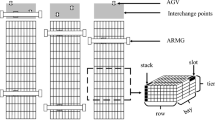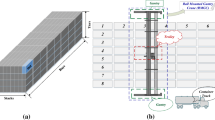Abstract
Although research on traditional terminals has been well developed, research concerning automated terminals and especially the yard space management is at the early stage. Backgrounded by the application of the upgrading automated technology, yard allocation requires compatible methods to interpret the emerging features of automated container terminals and coordinate with other operational systems. Considering the mixed stacking of import and export containers in one block and the cooperation among multiple yard cranes, this study provides the dynamic yard allocation method for automated container terminals. In this paper the space allocation problem of automated yard is examined through two stages. In Stage-I a bi-objective model is established to balance the workload between seaside and landside in each time window and optimize the total moving distances of containers from the yard to the berth. In Stage-II, by minimizing the moving distances of yard cranes from seaside, the specific allocation of the bay position in each time window is determined. Furthermore, by the application of the real-life cases of the automated terminal operations, it is verified that the proposed method and mathematical models are efficient to allocate the yard space which improve the yard management for the automated container terminal.










Similar content being viewed by others
References
Chen, L., & Lu, Z. (2012). The storage location assignment problem for outbound containers in a maritime terminal. International Journal of Production Economics, 135(1), 73–80.
He, J., & Tan, C. (2019). Modeling a resilient yard template under storage demand fluctuations in a container terminal. Engineering Optimization, 51(9), 1547–1566.
He, J., Tan, C., Yan, W., Huang, W., Liu, M., & Yu, H. (2020). Two-stage stochastic programming model for generating container yard template under uncertainty and traffic congestion. Advanced Engineering Informatics, 43, 101032.
He, J., Wang, Y., Tan, C., & Yu, H. (2021). Modeling berth allocation and QC assignment considering QC driver cost and operating efficiency. Advanced Engineering Informatics, 47, 101252.
Hu, H., Chen, X., Wang, T., & Zhang, Y. (2019). A three-stage decomposition method for the joint vehicle dispatching and storage allocation problem in automated container terminals. Computers & Industrial Engineering, 129, 90–101.
Jiang, X., Lee, L. H., Chew, E. P., Han, Y., & Tan, K. C. (2012). A container yard storage strategy for improving land utilization and operation efficiency in a transshipment hub port. European Journal of Operational Research, 221(1), 64–73.
Kim, K. H., & Park, K. T. (2003). A note on a dynamic space-allocation method for outbound containers. European Journal of Operational Research, 148(1), 92–101.
Kovalyov, M. Y., Pesch, E., & Ryzhikov, A. (2018). A note on scheduling container storage operations of two non-passing stacking cranes. Networks, 71(3), 271–280.
Ku, L. P., Chew, E. P., Lee, L. H., & Tan, K. C. (2012). A novel approach to yard planning under vessel arrival uncertainty. Flexible Services and Manufacturing Journal, 24(3), 274–293.
Liang, C., Liu, H., & Zhang, Y. (2018). Research on dynamic stacking strategy of automated container terminal. Computer Applications & Software, 35(10), 1–8.
Ma, H. L., Chung, S. H., Chan, H. K., & Cui, L. (2019). An integrated model for berth and yard planning in container terminals with multi-continuous berth layout. Annals of Operations Research, 273(1–2), 409–431.
Mi, W., Yan, W., He, J., & Chang, D. (2009). An investigation into yard allocation for outbound containers. COMPEL-the International Journal for Computation and Mathematics in Electrical and Electronic Engineering, 28(6), 1442–1457.
Park, T., Choe, R., Kim, Y. H., & Ryu, K. R. (2011). Dynamic adjustment of container stacking policy in an automated container terminal. International Journal of Production Economics, 133(1), 385–392.
Tan, C., He, J., & Wang, Y. (2017). Storage yard management based on flexible yard template in container terminal. Advanced Engineering Informatics, 34, 101–113.
Tan, C., & He, J. (2021). Integrated proactive and reactive strategies for sustainable berth allocation and QC assignment under uncertainty. Annals of Operations Research. https://doi.org/10.1007/s10479-020-03891-3
Tao, J. H., & Wang, M. (2009). Section allocation of container yard based on mixed mode. System Engineering Theory & Practice, 22(08), 15–16.
Wang, B. (2007). A dynamic random stacking method for container terminal yard. System Engineering Theory & practice, 21(04), 147-153+170.
Wu, Y., Luo, J., Zhang, D., & Dong, M. (2013). An integrated programming model for storage management and vehicle scheduling at container terminals. Research in Transportation Economics, 42(1), 13–27.
Yang, Y., Zhong, M., Yao, H., Yu, F., Fu, X., & Postolache, O. (2018). Internet of things for smart ports: Technologies and challenges. IEEE Instrumentation & Measurement Magazine, 21(1), 34–43.
Yu, H., Ge, Y. E., Chen, J., Luo, L., Tan, C., & Liu, D. (2017). CO2 emission evaluation of yard tractors during loading at container terminals. Transportation Research Part d: Transport and Environment, 53, 17–36.
Yu, H., Zhang, M., He, J., & Tan, C. (2020). Choice of loading clusters in container terminals. Advanced Engineering Informatics, 46, 101190.
Yu, M., & Qi, X. (2013). Storage space allocation models for inbound containers in an automatic container terminal. European Journal of Operational Research, 226(1), 32–45.
Zhang, C., Wu, T., Kim, K. H., & Miao, L. (2014). Conservative allocation models for outbound containers in container terminals. European Journal of Operational Research, 238(1), 155–165.
Zhen, L. (2014). Container yard template planning under uncertain maritime market. Transportation Research Part e: Logistics and Transportation Review, 69, 199–217.
Zhen, L., Yu, S., Wang, S., & Sun, Z. (2019). Scheduling quay cranes and yard trucks for unloading operations in container ports. Annals of Operations Research, 273(1), 455–478.
Acknowledgements
This work is sponsored by the National Natural Science Foundation of China [grant number 72072112, 72001135, 72002125]; Shanghai Rising-Star Program [grant number 19QA1404200]; Shanghai Sailing Program [grant number 20YF1416600, 19YF1418800].
Author information
Authors and Affiliations
Corresponding author
Additional information
Publisher's Note
Springer Nature remains neutral with regard to jurisdictional claims in published maps and institutional affiliations.
Appendix
Appendix
A1 Container volume to be allocated in each time window (TEUs)
t | |||||||||
|---|---|---|---|---|---|---|---|---|---|
Category | 9 | 10 | 11 | 12 | 13 | 14 | 15 | 16 | 17 |
Import container | 2000 | 2000 | 2000 | 4000 | 2000 | 2000 | 4000 | 4000 | 2000 |
Export container | 2200 | 3200 | 3000 | 2600 | 3200 | 2800 | 1800 | 1000 | 1000 |
A2 Container volume to be allocated in each time window (Bays)
t | |||||||||
|---|---|---|---|---|---|---|---|---|---|
Category | 9 | 10 | 11 | 12 | 13 | 14 | 15 | 16 | 17 |
Import container | 40 | 40 | 40 | 80 | 40 | 40 | 80 | 80 | 40 |
Export container | 44 | 64 | 60 | 52 | 64 | 56 | 36 | 20 | 20 |
A3 Distance from vessel berth to each block (m)
s | ||||||||
|---|---|---|---|---|---|---|---|---|
i | 1 | 2 | 3 | 4 | 5 | 6 | 7 | 8 |
Block1 | 115 | 315 | 195 | 435 | 115 | 195 | 435 | 315 |
Block2 | 155 | 275 | 155 | 395 | 155 | 155 | 395 | 275 |
Block3 | 115 | 235 | 115 | 355 | 115 | 115 | 355 | 235 |
Block4 | 115 | 195 | 115 | 315 | 115 | 115 | 315 | 195 |
Block5 | 155 | 155 | 155 | 275 | 155 | 155 | 275 | 155 |
Block6 | 195 | 115 | 115 | 235 | 195 | 115 | 235 | 115 |
Block7 | 235 | 115 | 115 | 195 | 235 | 115 | 195 | 115 |
Block8 | 275 | 155 | 155 | 155 | 275 | 155 | 155 | 155 |
Block9 | 315 | 115 | 195 | 115 | 315 | 195 | 115 | 115 |
Block10 | 355 | 115 | 235 | 115 | 355 | 235 | 115 | 115 |
A4 Dynamic distribution of container capacity in each container block (Bays)
t | |||||||||
|---|---|---|---|---|---|---|---|---|---|
i | 9 | 10 | 11 | 12 | 13 | 14 | 15 | 16 | 17 |
Block1 | 22 | 29 | 41 | 37 | 49 | 51 | 44 | 48 | 31 |
Block2 | 26 | 30 | 38 | 52 | 41 | 35 | 38 | 44 | 34 |
Block3 | 24 | 33 | 35 | 33 | 42 | 41 | 40 | 34 | 30 |
Block4 | 22 | 29 | 29 | 46 | 49 | 52 | 44 | 32 | 32 |
Block5 | 22 | 30 | 31 | 45 | 50 | 43 | 31 | 33 | 31 |
Block6 | 25 | 31 | 35 | 39 | 43 | 41 | 43 | 25 | 9 |
Block7 | 26 | 30 | 30 | 28 | 29 | 26 | 30 | 22 | 6 |
Block8 | 23 | 28 | 28 | 29 | 28 | 46 | 32 | 34 | 25 |
Block9 | 22 | 28 | 34 | 26 | 33 | 28 | 38 | 44 | 60 |
Block10 | 22 | 30 | 35 | 25 | 22 | 29 | 40 | 44 | 60 |
Rights and permissions
About this article
Cite this article
He, J., Xiao, X., Yu, H. et al. Dynamic yard allocation for automated container terminal. Ann Oper Res (2022). https://doi.org/10.1007/s10479-021-04458-6
Accepted:
Published:
DOI: https://doi.org/10.1007/s10479-021-04458-6




